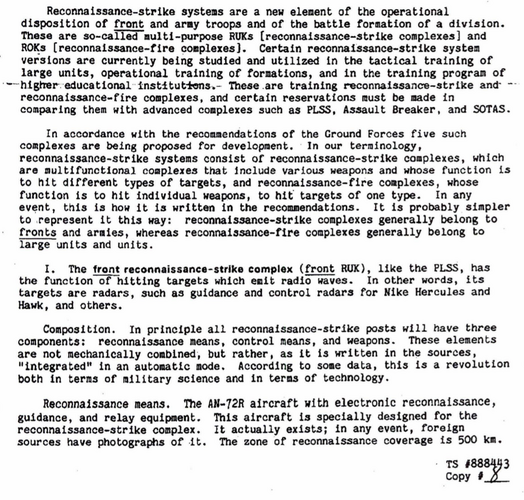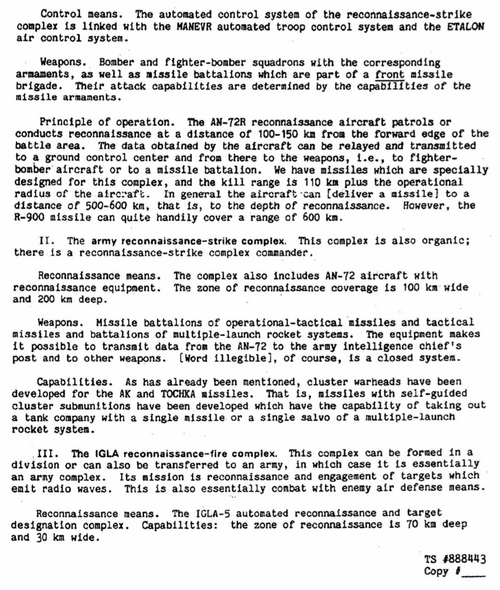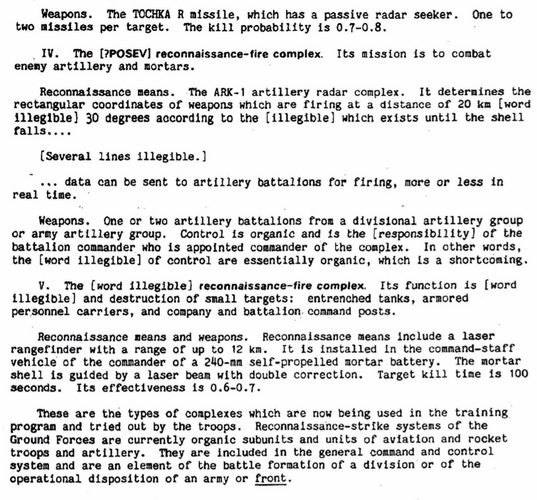You are using an out of date browser. It may not display this or other websites correctly.
You should upgrade or use an alternative browser.
You should upgrade or use an alternative browser.
Antonov An-72R "Izdeliyie 88"
- Thread starter boxkite
- Start date
- Joined
- 27 December 2005
- Messages
- 16,888
- Reaction score
- 21,589
Only the verbal description in Lotnictwo Wojskowe Rosji; An-72 with phased array antennas on each side of the fuselage.
- Joined
- 25 July 2007
- Messages
- 4,152
- Reaction score
- 3,795
Is the An-88 the same thing as the Izdeliye 88 / An-72R? According to FlankerMan on the Key Publishing Forum, a photo of the An-72R was published in AFM, November 2004
BTW, Deino was also on that forum. Might he have kept a copy of the An-72R image??
Edit: An-72R from Spyflight -- http://www.spyflight.co.uk/an72.htm
BTW, Deino was also on that forum. Might he have kept a copy of the An-72R image??
Edit: An-72R from Spyflight -- http://www.spyflight.co.uk/an72.htm
Attachments
- Joined
- 27 December 2005
- Messages
- 16,888
- Reaction score
- 21,589
There seem to be two stories about An-72R/An-88, one being that it was an AWACS project, one that it was some kind of recce machine with SLAR.
It seems unlikely to be SLAR if, as suggested, the radar panels are on both sides of the fuselage - as a standoff SLAR recce aircraft you would only want the radar on one side.
However, An-72R would seem to indicate a recce role.
It seems unlikely to be SLAR if, as suggested, the radar panels are on both sides of the fuselage - as a standoff SLAR recce aircraft you would only want the radar on one side.
However, An-72R would seem to indicate a recce role.
- Joined
- 2 January 2006
- Messages
- 3,622
- Reaction score
- 3,688
Apophenia said:...
BTW, Deino was also on that forum. Might he have kept a copy of the An-72R image??
...
Hmmm ... I saved three pictures ... the one Meteorit posted in the post before mine and these two ...
Hope it helps, Deino
Attachments
- Joined
- 1 April 2006
- Messages
- 11,032
- Reaction score
- 8,373
Posted by Anonymous at Aviaforum.Ru

 aviaforum.ru
An-72R has a Reg No.783573 [it carried unusual 6-digit registration, only used by several various type a/c of Antonov OKB in 1981-88 timeframe] and its buy No. №36572083573 is not matching reg No in the case. 83573 is a No. out of Kharkov Aircraft Factory (KhAZ) registration numbers row, and sources may be wrong. And it could be 35th An-72 in order built, and planned serial aircraft designation was planned as An-73 (while An-88 or 'airplane '88' designation is known as well). There was one more An-72R, BTW, but its Reg. No is unknown. Flight testing year was 1987.
aviaforum.ru
An-72R has a Reg No.783573 [it carried unusual 6-digit registration, only used by several various type a/c of Antonov OKB in 1981-88 timeframe] and its buy No. №36572083573 is not matching reg No in the case. 83573 is a No. out of Kharkov Aircraft Factory (KhAZ) registration numbers row, and sources may be wrong. And it could be 35th An-72 in order built, and planned serial aircraft designation was planned as An-73 (while An-88 or 'airplane '88' designation is known as well). There was one more An-72R, BTW, but its Reg. No is unknown. Flight testing year was 1987.

Авиационный форум AVIAFORUM.RU
Авиафорум - форум пилотов, пассажиров и любителей авиации. Новости авиапрома, безопасность полётов, рейтинг авиакомпаний, история авиации, вопросы карьеры и ВЛЭК, авиационная фотография.
- Joined
- 1 April 2006
- Messages
- 11,032
- Reaction score
- 8,373
A Tentative Fleet Plan
I really should change my personal text
- Joined
- 9 April 2018
- Messages
- 1,155
- Reaction score
- 2,573
The An-72R is briefly mentioned as the Reconnaissance portion of the Front and Army planned late-Soviet Reconnaissance Strike Complexes.



Source: https://www.archives.gov/files/declassification/iscap/pdf/2012-026-doc10.pdf



Source: https://www.archives.gov/files/declassification/iscap/pdf/2012-026-doc10.pdf
It was a SLAR recon plane according to this source.
- Joined
- 27 December 2005
- Messages
- 16,888
- Reaction score
- 21,589
Design features
Their characteristic external feature was the large fairings installed along the sides, under which the antennas of the target equipment were located. Outwardly, "product-88" is almost like an ordinary An-72 , but along the right and left side there is a flat fairing (the plane stands back from the side by a maximum of 0.2-0.3 m), approximately 13 — 14 of the total height of the fuselage, it starts in the area of the air intake, goes to the end of the chassis fairing, then moves up a small step and goes somewhere to the middle of the ramp. thus, the antenna of this radar is installed in the inflows on both sides of the fuselage.
The developer of the special complex was Moscow NPO "Palma" (chief designer A. A. Lebid). According to this program, three serial An-72s (ser. No. No. 01-04, 01-05, 02-01) were converted.
Purpose
To ensure the operation of the An-71, around 1988, the An-72BR repeater aircraft (An-72R, product "88") was developed with antennas of radio technical devices on the sides of the fuselage. An-72R was developed as an analogue of the Boeing E-8A J-Stars . It was intended for radar reconnaissance and long-distance detection of ground targets and targeting them with ground and air weapons.
Production
Production of all aircraft with the An-72R index was carried out at KhDAVP .
Research samples
4 prototypes were built by converting standard products into special-purpose aircraft.
The first of them has the serial number "Ser. No. 01-03" made its first flight in 1986 . It was an An-72R prototype with a regular (not enlarged) stabilizer.
A second aircraft was also ready in 1986 with the serial number "Ser. No. 01-04" and the aircraft number CCCP-783061
The third plane was ready in 1987 and had the serial number "Ser. No. 01-05" and ship number CCCP-783573. The tests took place on the territory of the RSFSR at the Zlet NGO .
The fourth aircraft from (ser. No. 10-09) was to be converted from standard equipment and design into An-72R. It was handed over to Oleg Antonov State Technical University in 1991 , and work on it continued until about 1994 . Then the work stopped. It remained in storage in Svyatoshino in a semi-dismantled state.
It was intended for radar reconnaissance, long-range detection of ground targets and targeting of "ground and air weapons". The developer of the special complex was Moscow NPO "Palma" (chief designer A. A. Lebid). According to this program, three serial An-72s (ser. No. No. 01-04, 01-05, 02-01) were converted.
Their characteristic external feature was the large fairings installed along the sides, under which the antennas of the target equipment were located. The planes were handed over to the Moscow NGO "Zlet" for tests, which could not be completed. Another An-72 (ser. No. 10-09) was sent to the Kyiv Mechanical Plant (KMZ) for conversion to pilot production in 1990 , but remained unfinished.
The current state of the program
After the military abandoned the An-71 in the early 1990s, work in this direction was stopped.
An-72R (ser. No. 10-09) at Svyatoshino airfield. Kyiv, September 2004
The An-72R prototype was equipped with a regular-sized stabilizer. In storage in Sviatoshyn without engines, avionics and any markings.
A second aircraft was also ready in 1986 with serial number "ser. #01-04" and aircraft number CCCP-783061 . Liaison plane. In storage in Kyiv-Svyatoshino.
The third plane was ready in 1987 and had the serial number "Ser. No. 01-05" and ship number CCCP-783573. The tests took place on the territory of the RSFSR at the Zlet NGO . Current status is unknown.
The fourth plane, half disassembled, is stored in Svyatoshino.
Source is Wikipedia and the source links don't seem to lead anywhere, so...
Ан-72Р — Вікіпедія
Similar threads
-
-
Drawings wanted to Antonov An-102 and An-104
- Started by hesham
- Replies: 2
-
-
-





